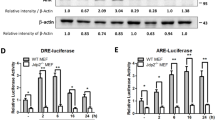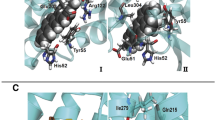Abstract
2,3,7,8-Tetrachlorodibenzo-p-dioxin (TCDD) is the most potent tumor promoter ever tested in rodents. Although it is known that most of the effects of TCDD are mediated by binding to the aryl hydrocarbon receptor (AhR), the mechanisms leading to tumor promotion still remain to be elucidated. Loss of contact inhibition is one characteristic hallmark in tumorigenesis. In WB-F344 cells TCDD induces a release from contact inhibition which is manifested by a two- to threefold increase in DNA synthesis when TCDD (1 nM) is applied to confluent cells. Since proliferation of epithelial cells is known to be inhibited by TGF-β, we investigated whether decreased TGF-β1 mediates TCDD-dependent release from contact inhibition in WB-F344 cells. Expression of TGF-β (type II) receptor in WB-F344 cells was analyzed by Western blot analysis. Exposure of 0.1 ng/ml TGF-β1 to exponentially growing WB-F344 cells resulted in a 40% decrease in DNA synthesis, which was blocked by preincubation with a neutralizing anti-TGF-β1 antibody, indicating that the TGF-β receptor in WB-F344 cells is functionally active. Preincubation of confluent, G1-arrested cultures with the neutralizing anti-TGF-β1-antibody did not lead to an increase in DNA synthesis, ruling out an involvement of TGF-β1 in mediating contact inhibition in WB-F344 cells. In accord with this, Western blot analysis revealed that protein expression of TGF-β1 is neither upregulated in confluent cultures nor decreased after TCDD treatment. We conclude that TGF-β1 is not involved in contact inhibition or in TCDD-dependent release from contact inhibition in WB-F344 cells.




Similar content being viewed by others
References
Barlat I, Henglein B, Plet A, Lamb N, Fernandez A, McKenzie F, Pouyssegur J, Vie A, Blanchard JM (1995) TGF-beta 1 and cAMP attenuate cyclin A gene transcription via a cAMP responsive element through independent pathways. Oncogene 11:1309–1318
Bertazzi PA, Zochetti C, Guercilena S, Consonni D, Tironi A, Landi MT, Pesatori AC (1997) Dioxin exposure and cancer risk: a 15-year mortality study after the “Seveso-accident.” Epidemiology 8:646–652
Buchanan DL, Ohsako S, Tohyama C, Cooke PS, Iguchi T (2002) Dioxin inhibition of estrogen-induced mouse uterine epithelial mitogenesis involves changes in cyclin and transforming growth factor-β expression. Toxicol Sci 66:62–68
Chramostova K, Vondracek J, Sindlerova L, Vojtesek B, Kozubik A, Machala M (2004) Polycyclic aromatic hydrocarbons modulate cell proliferation in rat hepatic epithelial stem-like WB-F344 cells. Toxicol Appl Pharmacol 196:136–148
Dietrich C, Faust D, Budt S, Moskwa M, Kunz A, Bock K-W, Oesch F (2002) TCDD-dependent release from contact-inhibition in WB-F344 cells: involvement of cyclin A. Toxicol Appl Pharmacol 183:117–126
Dietrich C, Faust D, Moskwa M, Kunz A, Bock K-W, Oesch F (2003) TCDD-dependent downregulation of γ-catenin in rat liver epithelial cells (WB-F344). Int J Cancer 103:435–439
Döhr O, Sinning R, Vogel C, Münzel P, Abel J (1997) Effect of transforming growth factor-β1 on expression of aryl hydrocarbon receptor and genes of Ah gene battery: clues for independent down-regulation in A549 cells. Mol Pharmacol 51:703–710
Elizondo G, Fernandez-Salguero P, Sheikh MS, Kim G-Y, Fornace AJ, Lee KS, Gonzalez F (2000) Altered cell cycle control at the G2/M phases in aryl hydrocarbon receptor-null embryo fibroblasts. Mol Pharmacol 57:1056–1063
Fernandez-Salguero P, Pineau T, Hilbert D, McPhail T, Lee S, Kimura S, Nebert D, Rudikoff, S, Ward J,, Gonzalez F (1995) Immune system impairment and hepatic fibrosis in mice lacking the dioxin binding Ah receptor. Science 268:722–726
Gonzales FJ, Fernandez-Salguero P (1998) The aryl hydrocarbon receptor. Studies using the AHR-null mice. Drug Metab Dispos 26:1194–1198
Guo J, Sartor M, Karyala S, Medvedovic M, Kann S, Puga A, Ryan P, Tomlinson CR (2004) Expression of genes in the TGF-β signaling pathway is significantly deregulated in smooth muscle cells from aorta of aryl hydrocarbon receptor knockout mice. Toxicol Appl Pharmacol 194:79–89
Hebert C, Cao Q-L, Birnbaum L (1990) Inhibition of high-density growth arrest in human squamous carcinoma cells by 2,3,7,8-tetrachlorodibenzo-p-dioxin (TCDD). Carcinogenesis 11:1335–1342
International Agency for Research on Cancer Working Group on the Evaluation of Carcinogenic Risks to Humans (1997) Polychlorinated dibenzo-para-dioxins and polychlorinated dibenzofurans. IARC Monographs on the evaluation of carcinogenic risks to humans, vol 69. IARC, Lyon
Kato M, Ishizaki A, Hellmann U, Wernstedt C, Kyogoku M, Miyazono K, Heldin C-H, Funa K (1995) A human keratinocyte cell line produces two autocrine growth inhibitors, transforming growth factor-β and insulin-like growth factor binding protein-6, in a calcium and cell-density-dependent manner. J Biol Chem 270:12373–12379
Köhle C, Gschaidmeier H, Lauth D, Topell S, Zitzer H, Bock K-W (1999) TCDD-mediated membrane translocation of c-Src protein kinase in liver WB-F344 cells. Arch Toxicol 73:152–158
Laemmli UK (1970) Cleavage of structural proteins during the assembly of the head of bacteriophage T4. Nature 227:680–685
Masssague J (1998) TGF-β signal transduction. Annu Rev Biochem 67:753–791
Münzel P, Bock-Hennig B, Schieback S, Gschaidmeier H, Beck-Gschaidmeier S, Bock K-W (1996) Growth modulation of hepatocytes and rat liver epithelial cells (WB-F344) by 2,3,7,8-tetrachlorodibenzo-p-dioxin. Carcinogenesis 17:197–202
Pitot HC, Goldsworthy T, Campell HA, Poland A (1980) Quantitative evaluation of the promotion by 2,3,7,8-tetrachlorodibenzo-p-dioxin of hepatocarcinogenesis from diethylnitrosamine. Cancer Res 40:3616–3620
Rowlands JC, Gustafsson J-A (1997) Aryl hydrocarbon receptor-mediated signal transduction. Crit Rev Toxicol 27:109–134
Santigo-Josefat B, Mulero-Navarro S, Dallas S, Fernandez-Salguero P (2004) Overexpression of latent transforming growth factor-β binding protein 1 (LTBP-1) in dioxin receptor-null mouse embryo fibroblasts. J Cell Sci 117:849–859
Schwarz M, Buchmann A, Stinchcombe S, Kalkuhl A, Bock K-W (2000) Ah receptor ligands and tumor promotion: survival of neoplastic cells. Toxicol Lett 112–113:69–77
Shi Y, Massague J (2003) Mechanisms of TGF-β signaling from cell membrane to the nucleus. Cell 113:685–700
Smith PK, Krohn RI, Hermanson GT, Mallia A, Gartner FH, Provenzano MD, Fujimoto EK, Hoeke NM, Olson BJ, Klenk DC (1985) Measurement of protein using bicinchoninic acid. Anal Biochem 150:76–85
Son DS, Rozman KK (2002) 2,3,7,8-Tetrachlorodibenzo-p-dioxin (TCDD) induces plasminogen activator inhibitor-1 through an aryl hydrocarbon receptor-mediated pathway in mouse hepatoma cell lines. Arch Toxicol 76:404–413
Sugiyama A, Nagaki M, Shidoji Y, Moriwaki H, Muto Y (1997) Regulation of cell cycle related genes in rat hepatocytes by transforming growth factor β1. Biochem Biophys Res Commun 238:539–543
Sutter TR, Greenlee WF (1992) Classification of the Ah gene battery. Chemosphere 25:223–226
Tsao M-S, Smith J, Nelson K, Grisham J (1984) A diploid epithelial cell line from normal adult rat liver with phenotypic properties of oval cells. Exp Cell Res 154:38–52
Whitlock JP (1993) Mechanistic aspects of dioxin action. Chem Res Toxicol 6:754–763
Zaher H, Fernandez-Salguero P, Letterio J, Sheikh MS, Fornace AJ Jr, Roberts A, Gonzalez F (1998) The involvement of aryl hydrocarbon receptor in the activation of transforming growth factor-β and apoptosis. Mol Pharmacol 54:313–321
Acknowledgements
We thank K.-W. Bock for kindly providing us with the WB-F344 cells, Sandra Niemann for excellent technical assistance, and Carsten Weiss for fruitful discussions. This work is part of the M.D. thesis of P.H. and was supported by the grant Di 793/1-3 by the Deutsche Forschungsgemeinschaft.
Author information
Authors and Affiliations
Corresponding author
Rights and permissions
About this article
Cite this article
Hoelper, P., Faust, D., Oesch, F. et al. Transforming growth factor-β1 is not involved in TCDD-dependent release from contact inhibition in WB-F344 cells. Arch Toxicol 79, 31–36 (2005). https://doi.org/10.1007/s00204-004-0601-0
Received:
Published:
Issue Date:
DOI: https://doi.org/10.1007/s00204-004-0601-0




